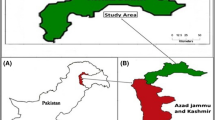Abstract
Intensive cultivation and long-term crop** are very important factors affect qualities and capability of soils for yield production. The current study aimed at using remote sensing and GIS for assessing the impact of intensive and long-term crop** on the capability of the soils and land degradation in Kafr Alshaikh Governorate soils for 55 years. The study used a previous data for the soils on the date 1961 and 2002 as well as collect a new data in 2016 for the same map** units. All data were subjected to a land capability classification model, according to FAO system. The data revealed that the change with time for the soil qualities and capability were as follows: the majority of the soils in 1961 (86.95%) were classified as C3 compared to 22.45% in 2016 while, in 2002 was the worst since almost all soils classified as C5. Nevertheless, year 2016 witnesses a great change in the capability most soils change to the C4 (77.55%) compared with the 2002 (0.31%). The most limiting factors for crop production were, soil depth, salinity, and alkalinity where the intensive use of soils with Rice cultivation under the use of heavy machinery increase the chance to raise the ground water tale depth as well as the chance to increase the soil salinity. The study endorsed to follow crop rotation in addition to follow management program by adding organic matter and deep plowing to relief the effect of intensive cultivation.











Similar content being viewed by others
References
AbdelRahman MAE, Shalaby A, Aboelsoud MH, Moghanm FS (2017) GIS spatial model based for determining actual land degradation status in Kafr El-Sheikh Governorate, North Nile Delta Model. Earth Syst Environ. https://doi.org/10.1007/s40808-017-0403-z
Afifi AA, Elsemary MA, Wahab MA (2014) A digital soil map** for sustainable agriculture and optimal soil management of Sharqya Governorate, Egypt. J Appl Sci Res 9(13):6596–6608
El Enain A, Sh A (1997) Use GIS, remote sensing and aerial photo-interpretation techniques for map** and evaluating soil improvement in some areas of north Nile Delta, Egypt. Ph.D. Thesis, Faculty of Agriculture, Cairo University
Elberson G, Catalon R (1987) Portable computers in physiographic soil survey. In: Proceedings of the international soil science congress, Homburg
ESRI (2009) ARC map version 9.3.1. User Manual, ESRI: ESRI product, California, 92373-8100, USA
Eswaran H, Bienforth FH, Reich P (2003) A global assessment of land quality. In: Wiebe KD (ed) Land quality, agricultural productivity and food security: biophysical processes and economic choices at local, regional and global levels. Publ. Edward Elgar, Northampton, pp 112–132
FAO (1964) High dam soil survey staff, vol III. Ministry of Agriculture, Giza
FAO (2007) Land evaluation, towards a revised framework. FAO, Rome
Ghosh S, Shetty A (2017) Modelling the land use system process for a pre-industrial landscape in India Model. Earth Syst Environ 3:703–717. https://doi.org/10.1007/s40808-017-0329-5
Hengl T, Rossiter D (2003) Supervised landform classification to enhance and replace photo-interpretation in semi-detailed soil survey. Soil Sci Soc Am J 67:1810–1822
ITT (2009) ITT Corporation ENVI 4.7 software, 1133 Westchester Avenue, White Plains
Janzen HH (1987) Effect of fertilizer on soil productivity in long-term spring wheat rotations. Can J Soil Sci 67:165–174
Larney FJ, Janzen HH, Olson BM (2000) Efficacy of inorganic fertilizers in restoring wheat yields on artificially eroded soils. Can J Soil Sci 75:369–377
Lillesand TM, Kiefer RW (2007) Remote sensing and image interpretation, 5th edn. Wiley, New York
Meshesha TW, Tripathi SK, Khare D (2016) Analyses of land use and land cover change dynamics using GIS and remote sensing during 1984 and 2015 in the Beressa Watershed Northern Central Highland of Ethiopia. Model Earth Syst Environ 2:168. https://doi.org/10.1007/s40808-016-0233-4
Mishra U (2009) Predicting storage and dynamics of soil organic carbon at a regional scale. Thesis of Ph.D., Presented in partial Fulfillment of the requirement for the degree of Doctor of Philosophy in the Graduate, School of the Ohio St University
Omran ESE (2006) Early warning information system for land degradation hazards. Model Earth Syst Environ (2016) 2:103. https://doi.org/10.1007/s40808-016-0148-0
Pravat KS, Gouri SB, Ramkrishna M (2016) Spatial analysis of soil properties using GIS based geostatistics models. Model Earth Syst Environ 2:107. https://doi.org/10.1007/s40808-016-0160-4
Quan RS, Liu M, Lu M, Zhang L, Wang J, Xu S (2010) Waterlogging risk assessment based on land use/cover change: a case study in Pudong New Area, Shanghai. Environ Earth Sci 61:1113–1121. https://doi.org/10.1007/s12665-009-0431-8
RISW (1961) Soil survey of Kafr El-Shaikh Governorate. Report No. 225
Sideruis W (1984) Rating of soil derived land qualities. Lectures Notes
Stori RE (1964) Handbook of soil evaluation, associated studies bookstore. University of California, Berkeley
Sys C (1991) Land evaluation, Part I and Ii, Lecture notes. Ghent University, Ghent
USDA (2004) Soil survey laboratory methods manual, soil survey investigation (2004) Report No. 42 Version 4.0
USDA (2014) Keys to soil taxonomy, 11th edn. United States Department of Agriculture, Natural Resources Conservation Service (NRCS)
Van Eerd LL, Congreves KA, Hayes A, Verhallen A, Hooker DC (2014) Long-term tillage and crop rotation effects on soil quality, organic carbon, and total nitrogen. Can J Soil Sci 94:303–315
Yasrebi J, Saffari M, Fathi H, Karimian N (2009) Evaluation and comparison of ordinary Kriging and invers distance weighting methods for prediction of spatial variability of some soil chemical parameters. J Biol Sci 4(1):93–102
Zare-Mehrjardi M, Taghizadeh-Mehrjardi R, Akbarzadeh A (2010) Evaluation of geostatistical techniques for map** spatial distribution of soil PH, salinity and plant cover affected by environmental factors in Southern Iran. Not Sci Biol 2(4):92–103
Author information
Authors and Affiliations
Corresponding author
Rights and permissions
About this article
Cite this article
Afifi, A.A., El Semary, M.A. The impact of long term crop** and land use change on the degradation of heavy clay soils in the Nile Delta, Egypt. Model. Earth Syst. Environ. 4, 805–814 (2018). https://doi.org/10.1007/s40808-018-0459-4
Received:
Accepted:
Published:
Issue Date:
DOI: https://doi.org/10.1007/s40808-018-0459-4




